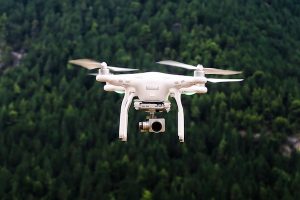Tech News
The Sky’s the Limit: Transforming Terrain Analysis with Drone Cartography
In recent years, the use of drones for cartography and terrain analysis has revolutionized the field of geospatial mapping. Drone cartography offers unparalleled advantages, including enhanced accuracy in terrain mapping, efficient and cost-effective data collection, and expanded accessibility to remote areas. These benefits have reshaped the way we approach terrain analysis and have opened up new opportunities for industries ranging from agriculture and land surveying to environmental monitoring and urban planning.
Advantages
Drone cartography provides an unprecedented level of accuracy in terrain mapping. By utilizing high-resolution imagery and advanced photogrammetry techniques, drones can capture detailed topographic data with remarkable precision. Integrating Drones into terrain surveys can streamline the data collection process, allowing professionals to gather accurate spatial information more efficiently than ever before. This level of accuracy enables professionals to create highly detailed and reliable maps, which is invaluable for various applications such as planning infrastructure projects, monitoring land use changes, and assessing environmental impact.
Furthermore, the use of drones for data collection significantly enhances efficiency and cost-effectiveness. Traditional methods of terrain analysis often involve time-consuming and labor-intensive field surveys or costly aerial photogrammetry using manned aircraft. In contrast, drones equipped with state-of-the-art sensors and cameras can rapidly capture data at a fraction of the cost, reducing the resources and time required for terrain mapping exercises.
One of the most compelling advantages of drone cartography is its ability to access and map remote or difficult-to-reach areas. Inaccessible terrain, such as rugged landscapes, dense forests, or hazardous environments, can now be effectively mapped using drones, providing valuable insights and information that were previously unattainable. This accessibility has empowered industries to expand their scope of geographic analysis and make informed decisions based on comprehensive spatial data.
Challenges
Despite the numerous advantages, implementing drone cartography is not without its challenges. Regulatory compliance and airspace restrictions are significant concerns that require meticulous attention when conducting aerial surveys using drones. Adhering to aviation regulations and obtaining the necessary permits and clearances is essential to ensure the safe and legal operation of drones for cartographic purposes.
Integration with Geographic Information Systems (GIS) poses another challenge in drone cartography. While drones provide geographical data, the seamless integration of this data with existing GIS platforms is crucial for effective analysis and visualization. This integration necessitates specialized skill sets and technical expertise to maximize the utility of drone-derived geospatial information within GIS applications.
Another challenge lies in the processing and interpretation of the vast amount of data collected through drone cartography. Managing and analyzing the copious volumes of imagery and spatial data requires advanced data processing techniques and specialized software tools. Additionally, ensuring the accuracy and reliability of the interpreted data demands attention to detail and rigorous quality control measures.
Best Practices
To maximize the potential of drone cartography, it’s crucial to integrate best practices with advanced technological solutions. An exemplary approach involves combining high-quality drones, such as those from DJI, with sophisticated RTK (Real-Time Kinematic) positioning systems like the one featured on the referenced page. This combination represents a fusion of drone technology with precise, multi-band RTK capabilities. This example of a DJI base station setup, therefore, stands as a symbol of precision in aerial mapping, offering centimeter-level accuracy. This integration not only elevates the precision of drone surveys but also significantly boosts their efficiency, making it an essential strategy for those seeking to achieve the highest standards in high-precision cartographic applications.
Optimal flight planning and route mapping are critical aspects of drone cartography. Careful consideration of flight parameters, including altitude, speed, and overlap of images, ensures comprehensive coverage and high-quality data capture. By optimizing these parameters and employing efficient route planning techniques, the effectiveness of drone surveys is maximized, leading to improved mapping results.
Maintaining data integrity and quality assurance throughout the entire cartographic process is paramount. Rigorous data validation, calibration of sensors, and adherence to standardized procedures for data collection and processing are essential to ensure the accuracy and reliability of the resulting maps. Quality assurance measures help mitigate errors and inconsistencies, thereby enhancing the overall quality of the cartographic outputs.
Future
Looking ahead, the future of drone cartography holds promising advancements and exciting possibilities. The integration of artificial intelligence (AI) and machine learning into drone-based mapping processes is expected to revolutionize the analysis and interpretation of geospatial data. AI algorithms can automate the identification of terrain features, extraction of relevant information, and even assist in the generation of maps with minimal human intervention, thereby increasing efficiency and accuracy.
Advancements in LiDAR (Light Detection and Ranging) and photogrammetry technologies are anticipated to further elevate the capabilities of drone cartography. LiDAR sensors, combined with drone platforms, enable the acquisition of highly detailed three-dimensional terrain models and vegetation mapping, opening new avenues for applications in forestry, urban planning, and geological surveys. Similarly, advancements in photogrammetry techniques enhance the resolution and accuracy of aerial imagery, providing richer and more detailed spatial information for analysis.
The future of drone cartography also encompasses enhanced collaboration with traditional surveying methods. Combining the strengths of drones with conventional surveying technologies, such as total stations and global navigation satellite systems (GNSS), presents opportunities for integrated approaches to terrain mapping and analysis. This synergy of technologies allows for comprehensive and multi-dimensional data collection, enabling more comprehensive insights into the Earth’s surface and subsurface features.





